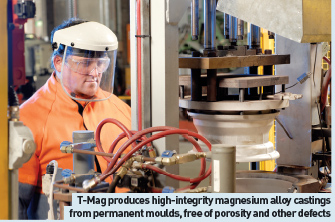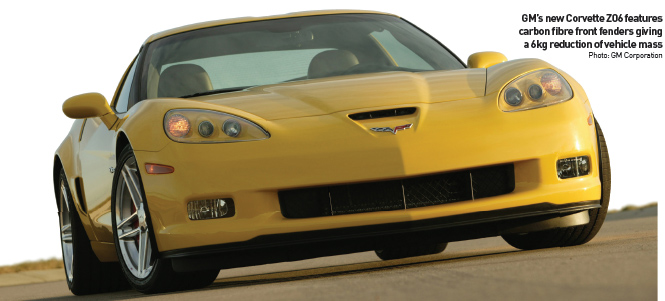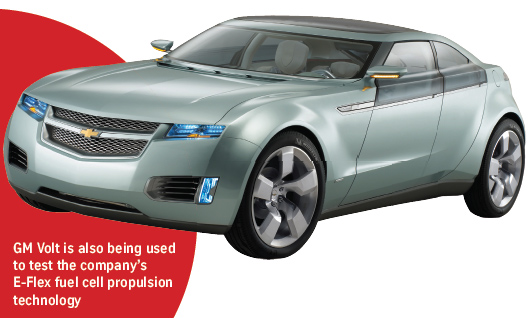The percentage of innovative lightweight materials in vehicles continues to increase, but so does the weight of the average car. What’s being done to balance the scales?
The recent signing of the Energy Independence and Security Act by President George Bush has brought the relationship between the aluminium, magnesium and lightweight materials markets and the auto industry into sharp focus. With the so-called Energy Bill requiring the US auto industry to raise its fleet-wide fuel economy average by 40 per cent, to 35 miles per gallon by 2020, the use of lighter materials in vehicle making for improved mileages is expected to considerably reduce steel supply to the automotive industry. Improved fuel consumption targets are due to be introduced as early as 2011. These new materials are expected to increase costs, meaning that customers will be asked to pay a premium at dealerships. That said, the impact of such increases should be somewhat mitigated by the potential savings in fuel expenditures over the life of the vehicle. “With new standards, historically the auto industry in the US has responded by lowering vehicle weight, which meant less steel and more aluminium, rubber and plastic,” says Mary Deily, Professor of Economics at Lehigh University in Bethlehem, US, who has studied the steel industry. As a rule of thumb, a 10 per cent decrease in vehicle weight yields an approximate 6 per cent improvement in fuel economy.
 To fully achieve the Energy bill’s fuel economy goals, automakers are also looking at enhanced engine and transmission efficiency using petrol-electric hybrid vehicles with reduced tyre rolling resistance and improved aerodynamics, says Alan Taub, Executive Director of Research and Development at GM. “The question is how to deliver this fuel economy with the best combination of technologies to deliver the highest value to customers,” Taub says.
To fully achieve the Energy bill’s fuel economy goals, automakers are also looking at enhanced engine and transmission efficiency using petrol-electric hybrid vehicles with reduced tyre rolling resistance and improved aerodynamics, says Alan Taub, Executive Director of Research and Development at GM. “The question is how to deliver this fuel economy with the best combination of technologies to deliver the highest value to customers,” Taub says.
Rising and falling rates
Today, steel accounts for about 60 per cent of an average vehicle’s weight in the US, down from a generation ago when steel made up a considerably higher percentage. That said, the average vehicle weight has risen by more than 25 per cent, to about 4,100lbs (1,860kg) over the past 20 years, helping to maintain the bottom line of steel providers to the auto industry. Even so, the percentage of aluminium in cars has been on the rise for decades, since the first rewrite of the US Corporate Average Fuel Economy (CAFE) rules, which were introduced in the late 1970s.
Alcoa, the country’s largest aluminium maker, sees great opportunities ahead. Company spokesman Kevin Lowery says aluminium costs will drop over time as automakers get Alcoa and other metal producers involved earlier in the production process in order to reduce waste. Hexcel, Zoltek and other carbon fibre makers also stand to benefit from tougher fuel economy rules. Their lightweight composite materials, which are significantly more expensive than steel, are already used in some Mercedes, BMW and Audi vehicles, and in GM’s new Corvette. It is also used in the aerospace industry, which is looking to drive down its jet fuel expenditures.
As aluminium and carbon fibre replace some steel, there will be a “fairly serious cost impact for consumers,” according to Larry Rinek, a senior automotive consultant with Frost & Sullivan. Those carbon fibre companies are already ramping up production to meet an anticipated surge in demand. But the mainstreaming of carbon fibre as a car-building material depends on prices coming down, and that can only occur with mass production, says Brian Yerger, an alternative energy analyst at Jesup & Lamont Securities.
Size and strength
While Europe favours smaller cars, manual transmissions and diesel engines to offset high fuel prices, US automakers believe they can make cars more energy efficient by using lighter materials, rather than sacrificing overall size. For example, in addition to state-of-the-art engines and power steering systems, Ford expects to use aluminium and lighter, high-strength steel to help trim down vehicles by between 250lbs to 750lbs per unit. Yet the currently tiny market for hybrids in the US continues to expand. In November 2007, sales of Toyota’s Prius, the most popular hybrid in the US, jumped 109 per cent, compared with a 5 per cent drop in sales of trucks and SUVs.
The American Iron and Steel Institute, whose members include Nucor Corporation and US Steel, says the fastestgrowing material being built into new vehicles is advanced, high-strength steel, developed to help automakers meet current fuel economy standards without compromising safety. It is more expensive than traditional low-carbon steel but lighter and not as costly as aluminium or carbon fibre. The transition to high-strength steel started ten years ago and today is “cost neutral”, according to Taub, as automakers can use less of the material per vehicle for an overall 25 per cent reduction in weight. Using a similar amount of aluminium provides up to a 45 per cent weight reduction when compared with a decade ago, while using magnesium and carbon fibre would offer weight losses of up to 60 per cent, but with significantly higher costs. About 20 per cent of domestic steel shipments currently go to US automakers and even if that figure shrinks, steel industry profits will be buffered by the higher prices paid for the lighter, higher-strength metal. “High-strength steel will remain the dominant car material for quite some time,” says Taub, “but you’ll see a greater proliferation of other materials.” Concessions and calculations US auto companies, which fought proposed changes to fuel standards for years, formed a close alliance during congressional consideration.
Congress requires fuel efficiency be tied to vehicle attributes such as weight. This gives manufacturers some flexibility to meet the new targets, beginning in 2011. Additionally, efficiency calculations for light trucks (SUVs, pickups and vans) will continue to be calculated separately from cars, which generally get better gas mileage. But the fleet make-up a dozen years down the road depends largely on what fuel savings technologies are adopted. “There is no one silver bullet out there for fuel efficiency,” says IRN analyst Erich Merkle. “It has to be a myriad of things, including reducing the weight of the vehicle, using more aluminium and hybrid technology.”
New launches
Auto companies planning gradual improvements are emphasising more efficient gasoline engines and a combination of alternative-fuel options, including ethanol and gasoline blends, electricity, gasoline-electric hybrids and hydrogen-powered vehicles. GM is betting on an upcoming electric car, the Volt, which is also being used to test the company’s E-Flex fuel cell propulsion technology, while Ford is planning a range of turbocharged direct injection gasoline engine technologies that the company says will provide fuel savings of between 10 and 20 per cent.
GM also plans to launch an average of one new hybrid model every three months for the next two years, including Saturn’s Vue Green Line 2 Mode, as well as a revamped Chevrolet Malibu range. Ford also plans to make half of its production capable of running on alternative fuels by 2012. “The new fuel economy standards within the bill set a tough, national target that GM will strive to meet,” according to GM company’s Chief Executive, Rick Wagoner.
Japanese automaker Honda Motor Company has the highest fleet mileage of any major automaker and it is planning a new mass-market hybrid for 2009. Honda claims this will set the new standard on a fleet-wide basis. “Where we’re going, the 35 mile-per-gallon standard will take a lot of resources and a lot of effort, but we can do it,” says John Mendel, Executive Vice President in charge of Honda’s US operations.
Toyota North America, the leader in hybrid technology, is considering a move to lighter materials to improve efficiency. This, while Land Rover puts forward the LRX concept, an SUV smaller than the current LR2 (or Freelander), that is set for launch in 2010. It is the latest example of how automakers worldwide are responding to pressure from consumers and government regulators to increase fuel efficiency, reduce carbon dioxide emissions and expand recycling efforts. With the possibility of even more stringent CO2 emissions regulations being introduced across Europe, Land Rover is being forced to adapt or face the consequences.
Light Land Rover
“We are as serious about sustainability as we are confident about the continuing relevance and desirability of our vehicles,” says Phil Popham, Land Rover’s Managing Director. Popham says the LRX was engineered to make it one of the cleanest vehicles in its class. It is lighter and has reduced aerodynamic drag, aiding fuel efficiency; recycled materials are used throughout. Although final engine details have yet to be released, it is anticipated that the LRX will feature a 2.0-litre diesel-electric hybrid unit capable of running on biofuel, together with the newly developed Electric Rear Axle Drive (ERAD). With an estimated CO2 output of 120g/km, the car is set to meet tough new emissions legislation, due to be introduced in 2012.
Land Rover is a comparatively small player in the global compact 4x4 market, measured against the Toyota RAV4 and Honda CR-V. What that means is, to make a decent profit, Land Rover will need to charge a premium for the LRX. “We are determined to make sustainability a key element in our future product design and the way we do business, while still creating vehicles that have a strong emotional appeal and fulfil people’s practical needs,” says Popham. “No one technology delivers all the answers to whole life sustainability, but the LRX concept brings together some of the ideas for the future that interest us; we believe it represents an exciting way forward for Land Rover.
Weight savings and strength are the benefits of new advances in the casting of super lightweight magnesium alloys by a team of research engineers from CSIRO, Australia’s Commonwealth Scientific and Industrial Research Organisation.
Also supported by Australia’s Alloy Technologies International, Flotek and Sage Automation, together with an AUS$1.95m Commercial Ready grant from the Australian government, this new technology, known as T-Mag, consistently produces high-integrity magnesium alloy castings from permanent moulds, the products free of porosity and other defects. T-Mag reportedly produces parts of such quality that the resulting magnesium casts can be used as direct replacements for equivalent steel or aluminium parts.
Lightweight block
T-Mag casts lightweight magnesium-alloy engine blocks that are only two-thirds the weight of current aluminium alloy blocks and less than one third the weight of cast iron blocks, a prospect that is already arousing the interest of European high-performance car manufacturers. Other benefits include a 15 per cent-quicker process over the equivalent aluminium casting due to the lower specifi c heat of magnesium.
The method also allows the manufacture of high-integrity, cast magnesium alloy wheels, products that current casting technology is unable to produce to a standard high enough for safe road use. Developed through CSIRO’s Light Metals Flagship by a team from CSIRO Manufacturing and Infrastructure Technology, T-Mag is a pilot-scale operation built for research and development. Yet it has already successfully produced cast magnesium road wheels and engine blocks for a 750cc, water-cooled motorcycle engine.
CSIRO believes that T-Mag’s technical and economic attributes will give it a competitive advantage over current casting technologies, while removing many obstacles to the economic production of high-integrity magnesium parts.
Advanced applications
Head researcher, Dr Thang Nguyen, describes T-Mag’s novel integrated design as a critical enabling technology, offering a range of applications beyond the high-pressure casting technique currently used to produce 85 per cent of the world’s magnesium alloy components. High-pressure die casting has limitations that restrict its automotive applications, notably the low-as-cast yields, meaning it typically takes 6-7kgs of metal to produce a 3.5kg casting. “In sand and high pressure die casting, the runners, overflows and risers have to be large to get the metal from the source to the casting. The excess metal is not part of the casting and needs to be recycled, which results in a low yield,” says Sam Tartaglia, Business Development Manager for CSIRO’s Light Metals Flagship.
The unused metal cannot simply be recycled because re-melting creates impurities such as oxides and inter-metallic compounds, while both the initial melting process and re-melting of the scrap consume large amounts of energy. “T-Mag requires only 3.7kg of alloy for a 3.5kg casting. This reduces recycling and energy use, saving a lot of melt cost,” explained Dr. Nguyen. While sand cores do not support high injection pressures, T-Mag is a process that combines the best features of all permanent mould casting processes. It is a permanent-mould casting process that requires neither applied pressure nor a vacuum to fi ll the die. The magnesium die fl ows up from the bottom of the mould, minimising fl ow turbulence, which in turn reduces oxide generation and gas entrapment in the casting. This results in nearly defect-free castings, with reduced excess metal and an X-rayquality final casting.
The T-Mag casting machine combines melting and casting in a single, compact unit. Unlike high-pressure die casting, T-Mag allows the incorporation of sand cores, allowing complex internal features in products such as engine blocks, cross members and motorcycle swing arms to be produced. “We see the CSIRO work as synergistic with the work at Brunel University on melt conditioning of magnesium,” says Geoff Scamans of UK-based Innoval Technology. “It is possible to feed a conditioned melt into the T-Mag casting process to obtain additional benefi ts in terms of the range of castable alloys, the use of non-refi ned scrap and the provision of fi ner, more uniform as-cast microstructures.”
The Australian Light Metals development has the potential to turn traditional magnesium processing technology on its head. The T-Mag process can still use sand cores to produce complex hollow features inside magnesium castings and, coupled with its very economical use of the material, it opens up a vast range of new uses. These castings can also be heat treated and welded, adding more scope for the use of magnesium in many areas. Industry Minister Ian Macfarlane made the announcement, saying the new manufacturing system reduced waste and increased energy efficiency, making the new technology an exciting prospect for the automotive component industry.
“The new technology can be used in a range of applications where carmakers are in search of that global goal of improving power-to-weight ratios,” says Macfarlane. The team is also investigating the use of different alloys to suit specific applications. They are particularly interested in new-generation alloys for elevated temperature applications, however little is currently known about the performance of these alloys with the T-Mag process. Ongoing research and development by the team will be focused on optimising process control to ensure T-Mag produces consistent casting quality at a reasonably low cost. This includes aspects of the process such as thermal control, die coat, metal filters, casting defect minimisation and die design. Computer simulation also plays a signifi cant part in this programme.


































